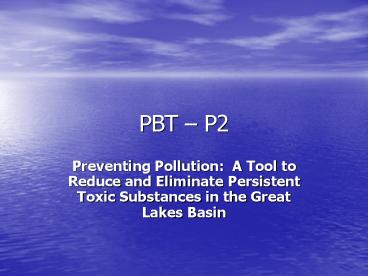PBT PowerPoint PPT Presentation
1 / 7
Title: PBT
1
PBT P2
- Preventing Pollution A Tool to Reduce and
Eliminate Persistent Toxic Substances in the
Great Lakes Basin
2
Through collaboration, shared value, and applied
problem solving, P2 can influence the management
of PTSs by
- Reducing treatment, transport, and disposal costs
- Minimizing compliance issues and cost associated
with regulated wastes - Reducing future liability through reduced risks
to workers, communities, and the environment - Avoiding costs of accidents and spills
- Improving production times
- Enhancing public image and community relations
3
Examples of successful P2 practice in the Great
Lakes Basin include
- Household Hazardous Waste Collections
- Mercury Free Hospitals and schools
- Tribal Burn Barrel Strategies
- Pesticide Cleansweep Programs
- Regulatory actions
- By targeting specific sources of use, such as
- schools, hospitals, end-of-life automobiles and
dental offices - 505 lbs. of elemental mercury recovered from auto
switches bound for crushing and shredding
operations (NY) - 8,187 mercury containing devices reclaimed from
households, school laboratories, doctors offices
and clinics, recovering 621 lbs. of mercury (MI)
4
Current and Future Considerations
- As the global market for manufactured goods
becomes more competitive, improved efficiency in
the use of natural resources is integral to a
sustainable economy and society. Waste reduction
and the elimination of potentially harmful
substances in the design of products is now
becoming an important principal in how things are
made. - Corporate Social Responsibility (CSR)
- Environmental Management Systems (EMS)
- Green Engineering
- Green Chemistry
- Design for the Environment (DfE)
- Environmentally Preferred Purchasing (EPP)
5
What is working
- The cyclical use of materials
- Targeting specific toxic chemicals for
replacement - Defining materials flows is resulting in the
creation of products designed to be recycled - Service oriented programs are also being created
to take back products at end of life - The use of alternative fuel and energy sources is
also considered a marketable indicator in new the
Green Label Initiative - Offering incentives financial, regulatory,
public perception
6
Where we are going
- The waste reduction and elimination models now
being practiced in some industries provide a new
vision - If we consider that in all natural systems, waste
equals food, ecosystem sustainability is an easy
concept to grasp - Innovative solutions through strong partnerships
are needed to recognize that in both human and
natural systems, sustainability is an outcome of
relationships among the parts
7
What is missing
- Larger scale coherent P2 plan
- Many local/regional successes but no larger scale
program to tie together - No prioritization by contaminant, mode of
release, etc. - Integration with other efforts
- P2 can play a role in many areas (drinking water,
wastewater, clean air, AOC cleanup, groundwater,
WTE, power generation, etc.), but not all parties
are at the table - Methods to learn from mistakes
- Focus on lb kept from environment precludes
learning from failures

